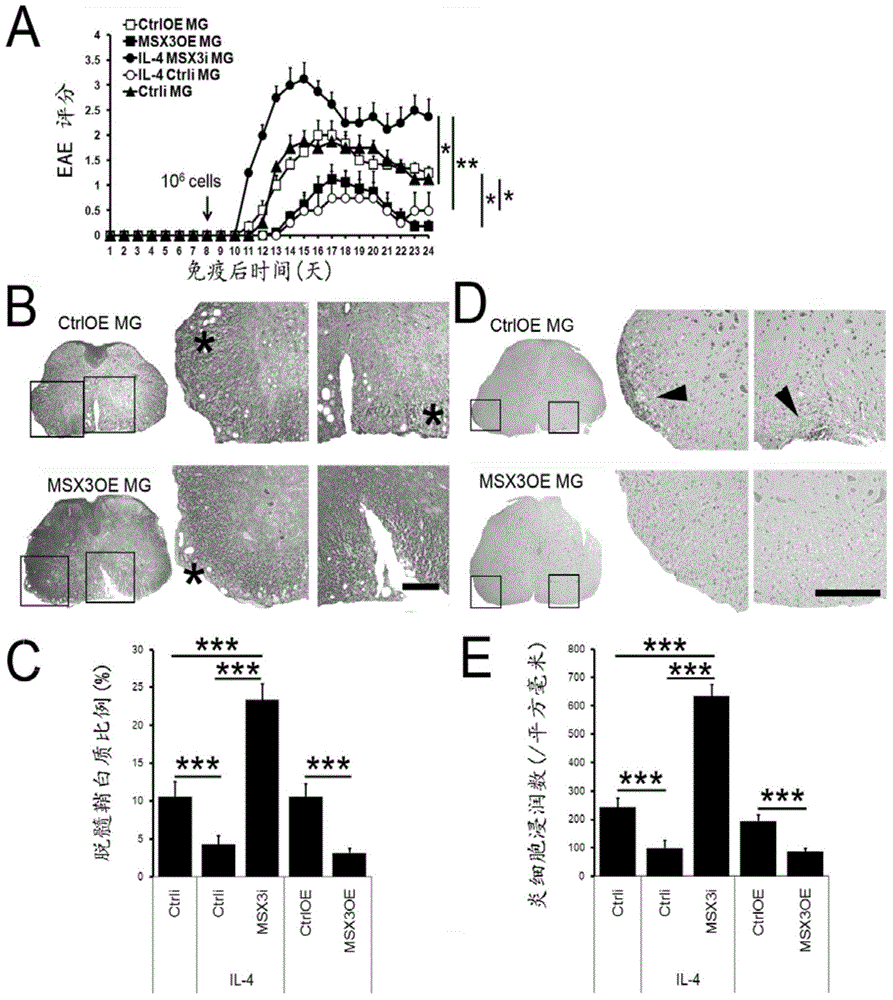Method of specifically inducing microglial cell selective polarization with MSX3 gene and application of same
A technology of microglia and MSX3, applied in the fields of genetic engineering and medicine, can solve the problems that there is no research on MSX3, no effective means for microglia, and unclear regulatory mechanism
- Summary
- Abstract
- Description
- Claims
- Application Information
AI Technical Summary
Problems solved by technology
Method used
Image
Examples
Embodiment 1
[0087] Example 1: Construction of lentiviruses to overexpress MSX3-GFP and interfere with MSX3i-GFP, and infect mice and human microglia.
[0088] 1. Purification and preparation of microglial cells
[0089] Preparation of mouse microglia by primary culture. Human microglia were from SCIENCELL.
[0090] 2. Preparation of microglial total RNA
[0091] The total RNA of human epidermal cells was extracted by the conventional guanidine isothiocyanate method with the total RNA extraction kit of Shanghai Sangon Bioengineering Co., Ltd. Methods as below:
[0092] Take a 3.5cm-diameter petri dish of microglia growing in a single layer, discard the medium directly, add 1ml of TRIzol to dissolve the cells, and remove the cell lysate with a pipette after the cells are fully dissolved. The cell lysed samples were incubated at 15-30°C for 5 minutes to completely decompose the ribosomes. Add 0.2ml of chloroform to every 1ml of TRIzol, close the cap of the sample tube, shake the tube by...
Embodiment 2
[0130] Embodiment 2: cell experiment (in vitro experiment)
[0131] Using biological experimental methods such as immunocytochemistry, the changes in cell morphology, target gene expression, cell viability, axon growth, and myelination were analyzed from various aspects such as cell morphology and myelin-related protein expression (MBP).
[0132] The specific method is as follows:
[0133] 1) Detection of OPC differentiation and neurite outgrowth by immunocytochemistry
[0134] (1) The MSX3 interference type and overexpression type virus obtained in step 4 (7) of Example 1 were transfected into microglial cells, the medium was changed after 24 hours, and cultured for 3 days, the conditional supernatant was collected and mixed with OPC (Oligodendrocyte precursor cell , oligodendrocyte precursor cells) (10 000 cells / well seeded in 24-well plates) or cortical and hippocampal neurons (10 000 cells / well seeded in 24-well plates) were co-cultured for 120 hours. At each time point,...
Embodiment 3
[0144] Example 3: In Vivo Cell Transplantation Test
[0145] The mice used in the experiment were female C57BL / 6 strain, SPF grade. Weight about 20 ~ 25g, 8 weeks old, purchased from Shanghai Experimental Animal Center. A total of 40 animals were divided into 5 groups of virus transfection groups: Ctrl group (control interference virus transfection for 72 hours), MSX3i+IL-4 group (MSX3 interference virus transfection for 72 hours and IL-4 stimulation for 24 hours), Ctrl+IL -4 groups (contrast interference virus transfection for 72 hours and IL-4 stimulation for 24 hours), MSX3OE group (MSX3 overexpression virus transfection for 72 hours), CtrlOE group (contrast overexpression virus transfection for 72 hours). Extract the MG obtained in Step 4 of Example 1 with a 10 μl syringe Ctrli , MG Ctrli+IL-4 , MG MSX3i+IL-4 , MG CtrlOE and MG MSX3OE The cells were centrifuged to prepare 2 μl of cell suspension, and transplanted into the lateral ventricle of mice on the 8th day afte...
PUM
 Login to View More
Login to View More Abstract
Description
Claims
Application Information
 Login to View More
Login to View More - R&D Engineer
- R&D Manager
- IP Professional
- Industry Leading Data Capabilities
- Powerful AI technology
- Patent DNA Extraction
Browse by: Latest US Patents, China's latest patents, Technical Efficacy Thesaurus, Application Domain, Technology Topic, Popular Technical Reports.
© 2024 PatSnap. All rights reserved.Legal|Privacy policy|Modern Slavery Act Transparency Statement|Sitemap|About US| Contact US: help@patsnap.com










